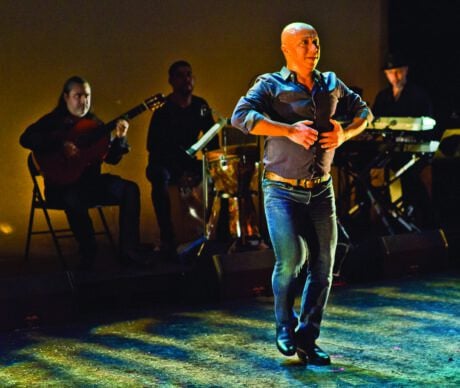When a technician noticed a lighting cue had come later than planned (the dancing took over), Aleksey Kulikov, co-director of Flamenco Aparicio Dance Company, explained to the crew member: “That’s flamenco.”

Together he, his counterpart, Edwin Aparicio (choreographer, co-director, and dancer), and their talented team of dancers, singers, and instrumentalists, turned the GALA Hispanic Theatre into a beacon of hope, strength and the power of the human spirit.
Between mesmerizing pieces, intercut video interviews with the dancers unfurled each of their stories. The theme of the evening’s performance, Flamenco Extranjero (extranjero translates to ‘foreign’) was flamenco, yes, but flamenco danced by those who enter into the art form as foreigners themselves – sometimes perceived as outsiders – those versed and captivated by the culture, practice, technique of the dancing, but not from Spain. Aparicio and Kulikov, for example, hail from El Salvador and Ukraine, respectively.
As the co-directors note, flamenco dancing, which originated in Romani communities in the Andalusia region of Spain, also has regional Spanish, Moorish and Jewish musical and dance influences, but even boasts others. While most of the pieces were choreographed in this production, some of the most beautiful, unexpected moments were the result of improvisation, when flamenco dancers and musicians communicate, in their own language, on the spot – flexibility, liberation from the strictly codified, which flamenco not only allows, but celebrates.

The diverse backgrounds of the Aparicio Dance Company troupe (Belgian, Ukrainian, El Salvadorian, French, Japanese, German, Mexican) bring a unique quality to this particular show.
Aparicio, whose legendary flamenco instructors include Tomás de Madrid and La Tati, received a Cross of the Order of Civil Merit from King Felipe VI of Spain in 2015. He is currently a staff member at The Washington Ballet and was previously a soloist with the José Greco Spanish Dance Company.
Aparicio was one of Dance Magazine’s “25 Dancers to Watch” in 2009. “You have” should be inserted after “dancers,” to put it mildly. To refer to his tranquil fervor is to use an oxymoron, but there is a tension embedded in the flamenco movements that he performs through with striking evenness and precision. The head turns sharply – snaps – while hands and wrists twist and turn with fluidity.

For a dancer, this is a balancing act of quietly cosmic proportions, to master the art of manipulating each body part, each motion, separately – until it becomes a unified whole. Aparicio, in addition, multitasks on another level: “When I’m dancing, I still have to be concentrating, as the director, on the whole production – on what comes next.”
The effect of Aparicio and his other beautiful dancers (Norberto Chamizo and Kyoko Terada made a particularly memorable, formidable pair in (A Postcard from Spain) is to speak to not only flamenco dance’s power, but the power of the individual, the dancing human body. As one dancer noted in her interview, flamenco evolved from “oppressed people.”
Flamenco Extranjero the show was a triumph because we saw dance allow people to triumph above all. There was a vivacity created, a roar of the present, perhaps the kind that can only come from – and in the end overcome – the pain of the past.
Running Time: Approximately one hour and 30 minutes, with an intermission.
Fuego Extranjero plays this weekend only, Friday, November 3 and Saturday, November 4 at 8:00 pm and Sunday, November 5 at 2 pm at GALA Theatre – 3333 14th Street NW, in Washington, D.C. as part of the 13th Annual Flamenco Festival. The Festival runs through November 12. For tickets, visit them online.






Great review! You’ve really communicated the genius and power of this group.
Thank you, Madeline, for such thoughtful review.
– Aleksey & Edwin